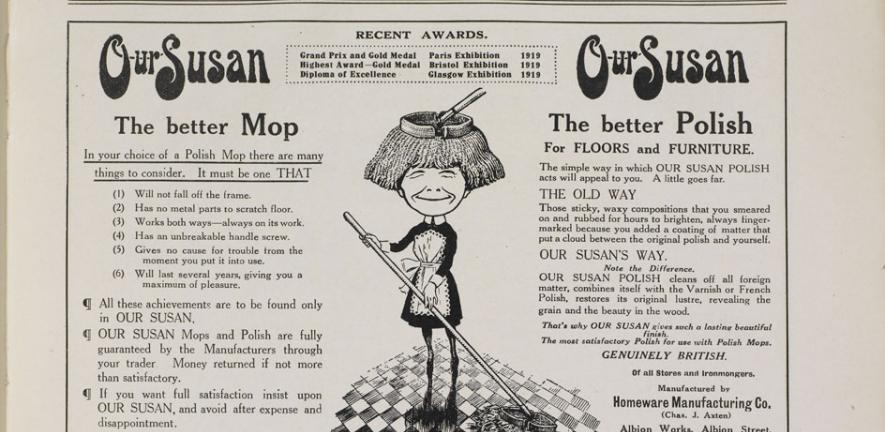
From the fictional Downton Abbey to the modest suburban semi, domestic service has had a prominent role in the story, whether real or imagined, of British society over the past 100 years. In Knowing Their Place: Domestic Service in Twentieth-Century Britain, Cambridge historian Dr Lucy Delap navigates the shifting drama played out in that most intimate and domestic workplace: the home.
From the fictional Downton Abbey to the modest suburban semi, domestic service has had a prominent role in the story, whether real or imagined, of British society over the past 100 years. In Knowing Their Place: Domestic Service in Twentieth-Century Britain, Cambridge historian Dr Lucy Delap navigates the shifting drama played out in that most intimate and domestic workplace: the home.
The discomforts and encounters of domestic service have been taken to stand in for the ‘spirit of the times’. Domestic service has served as a foundational narrative among the stories British people tell about the last century and its changes.
Dr Lucy Delap
Throughout the 20th century, domestic service had a compelling presence in British economic, social and cultural life. For the first half of the century, it employed the largest numbers of women of any labour market sector in Britain. Predominantly female, these servants worked in other people’s homes, where they did not only the dirty work but also formed deep attachments to those they worked for, and lived out their lives under the same roof as their employers.
In Knowing Their Place: Domestic Service in Twentieth-Century Britain Cambridge University historian Dr Lucy Delap suggests that domestic service has not only survived the profound changes of two World Wars and the social revolution of the 1960s – but remains right at the heart of everyday British life, as increasing numbers of households juggle full-time work and demanding dual careers with parenting. Domestic service was no feudal or Victorian institution, but should be seen as thoroughly modern, constantly reinvented and remodelled as an integral feature of 20th-century Britain.
The upheavals of the First World War, combined with alternative work such as retail and clerical employment for women, saw a dramatic fall in numbers of residential servants. However, the interwar depression, state welfare policies and media pressure combined to push many women back into the domestic service sector in the 1930s. Nonetheless, many felt that the end was in sight and servants were increasingly unwilling to ‘live in’. Domestic service, J B Priestly had declared with breath-taking bluntness in 1927, was “as obsolete as the horse” in an era of motor cars.
After the Second World War, the popular press became preoccupied with a new concept for middle-class living: the servant-less home. This was a home in which labour-saving devices took the place of the people who had once cooked, mopped and scrubbed – and uncluttered furnishing styles promised to make cleaning quick and easy. Servants – whether imagined in rosy hues, or distrusted and demeaned– were apparently no longer needed. Far fewer working women chose this occupation, and it became dominated by informal cleaners, refugees and migrants, occupying new roles such as the ‘au pair’.
But middle class households were still permeated by talk of servants and how to live without them, while an unseen and largely unsung army of cleaners, nannies and au pairs continued to perform housework and childcare. And in the 1980s, as unemployment rose and the gap between rich and poor widened, numbers of domestic workers rose sharply again. As Margaret Thatcher advised an audience of professional women in 1990: “You have to seek reliable help—a relative or what my mother would have called ‘a treasure’.”
With the nomenclature used for those who served changing – from maid or the more colloquial Mary Ann to the more neutral ‘help’, and from mistress to ‘hostesses’ or ‘housemistresses’, ‘knowing their place’ became increasingly uncertain for all concerned. Nonetheless, the same negotiations of power, status and deference can be seen through the generations– for example, through the revealing issue of toilet paper. What quality of paper should one provide for staff? And what do they do with all that toilet paper anyway? These concerns caused as much angst in a 2005 thread discussing au pairs on the internet forum ‘mumsnet’ as in interwar households.
The housewife identity which developed after the Second World War was accompanied by a rebranding of domestic work as ‘scientific’ or ‘household engineering’, as houses began to gain plumbing, and move to gas or electricity for heat and light. But the old practices (sweeping rugs with tea leaves, jugs of water for personal washing, the dolly and mangle for laundry) remained common well past the 1940s, and the modern devices purchased were often marketed as for use by servants, or evoked their haunting presence. It is no co-incidence that many of the appliances launched to fill these gaps had carefully chosen female names: the ‘Our Susan Mop’, the ‘Sheila’ Clothes Airer (still available), the Marigold rubber gloves that kept middle class hands soft and free of the smell of dirty dish water.
Countless British homes still featured dark basement kitchens and labour-intensive furnishings throughout the last century. Even avowedly modernist visions of the home were slow to evolve away from the idea of service, and depicted maids bedrooms and staff quarters. In 1930, Good Housekeeping presented the telephone as making domestic service more efficient: “the voice of the mistress can be clearly heard by the maid, who transmits her reply by telephone.” ‘Modern’ and ‘up-to-date’ inventions of the 1960s such as take-away food were marketed as aiming to “fill the gap left by the vanished race of servants”. The absent servants - who maintained a level of comfort and stability that allowed for professional careers and elaborate social schedules among middle class women - left holes behind them akin to ghosts.
Delap charts the encounters of servant-keeper and servant, seen from both points of view, by looking at three generations of women: those born in the late Victorian period, those entering adulthood after the First World War, and those coming of age after the Second World War. As the century unfolded, bringing with it the rise of the suburbs and new intimacies of family life, the home was the setting for an intimate drama, the housewife (a hotly debated term across the entire 20th century) negotiated the physical labour of running a house, and the symbolic meaning of such work. Delap argues that our relationship with domestic labour has never been just practical: “The discomforts and encounters of domestic service have been taken to stand in for the ‘spirit of the times’. Domestic service has served as a foundational narrative among the stories British people tell about the last century and its changes.”
These households represented a huge diversity of environments and workplaces. Knowing Their Place describes the Edwardian Barnsley coal merchant who required his maid to take off his dirty boots and place his slippers on his feet; the dead infant found in the trunk of a servant of a working-class Hull family; the Birmingham bungalow in which a Second World War mistress attempted to impose an ‘upstairs, downstairs’ regime, despite the intimacy of her confined domestic space; the 1950s London Jewish home where master, mistress and servant all cooked and laughed together in the basement kitchen; the 1940s Rochdale suburban house where another Jewish family were ostracised by their neighbours for daring to take on a cleaner; the Hendon au pair forbidden from taking a biscuit from the plate she passed round to guests in the 1960s.
Fascinating for the contemporary reader is Delap’s detailed analysis of the shock and loss (and this is not to overdramatise the case) that middle class families felt at the absence, or much curtailed presence, of domestic service in the post-war years, when those brought up by nanny became expected to look after their own households . The necessity of “doing for oneself” had far-reaching social consequences that were reflected in the marketing of domestic gadgets and revised social conventions to disguise the lack of help, new models of child raising, new styles of cooking - the simple recipes The Times still referred to as ‘servantless dishes’ in 1970. And this also went with an intensifying frustration among middle class women, who rarely identified wholeheartedly with the housewife identity, and began to demand changes in the behaviour of their husbands.
Many women were not easily persuaded that housework was ‘scientific’ and satisfying. One mother of a large family, employing a ‘daily girl’ commented in the 1950s: “My own life at the moment seems a dull waste, a vale of (unshed) tears, an empty vessel, a froth of frustration… I am bored, bored, BORED.” It was partly this frustration that led to the rise of feminism in the 1970s. Nonetheless, the feminist movement rarely produced much fresh thinking on alternatives to domestic service. One servant wrote furiously to an Edwardian feminist advocate of cooperative living that “Methinks that this common ownership of domestic drudges would not be quite so satisfactory from the domestic drudge’s point of view.” Late in the 20th century, Germaine Greer famously advocated in the Female Eunuch that feminists should live collectively in an Italian farmhouse, assisted by a live-in “local family”.
Being servantless was never embraced among the middle classes as a sign of modernity, but was something to be masked by elaborate subterfuge, clever interior design (serving hatches, lobbies and passages all acted as devices for separation and buffers to the odours of cooking), and a pretence that there was a cook in the kitchen and a maid to wait at table. In one example of the charade played out to disguise the absence of a maid, on hearing the door bell, the lady of the house would pick up her hat and gloves and appear to be going out just at that very moment, in which case propriety allowed her to greet her visitor herself.
Our enduring fascination for domestic service runs through literature, film, comedy pornography and popular history in contemporary Britain. Delap is intrigued by the rise of the domestic service costume dramas, reality TV series and heritage attractions, starting with Upstairs, Downstairs in 1971. Why did domestic service suddenly come to feature so prominently in our broadcasting and heritage houses? The erotic appeal of service – the imagined seduction, sexual vulnerability – is clearly part of this, and Delap charts the strong presence of domestic servants in pornography and erotica – from the Edwardian ‘what the Butler saw’ machine, to the 1970s Carry On Emmanuelle and more recently, Servants. Upstairs, Downstairs was originally written to show class inequalities, but the production company marketed it as revealing “a preponderance of frustrated females below stairs... love affairs of every sort were unrestrained”. Others wanted to see a nostalgic vision of a servant-keeping society where all ‘knew their place’. This meshed well with the 1980s conservative political mood.
More recent depictions of domestic service – Gosford Park, The Remains of the Day, The 1900 House – have been less rose-tinted, and more interested in the emotional and physical demands of the job. The Remains of the Day depicted both servants and employers as scarred and stunted by their experiences of domestic service. But viewers have sometimes retained their nostalgia. With an apparent absence of irony, a London hotel took its employees to see the film in 1994, hoping to inculcate more deferential behaviour. One of the staff commented “It was so gracious the way the staff worked together… The butler was so at ease with himself, so professional. It does make you think you want to be like that.”
Lucy Delap is a Fellow and Director of Studies in History at St Catharine’s College, Cambridge. Knowing Their Place: Domestic Service in Twentieth-Century Britain is published by Oxford University Press, 2011.
This work is licensed under a Creative Commons Licence. If you use this content on your site please link back to this page.





